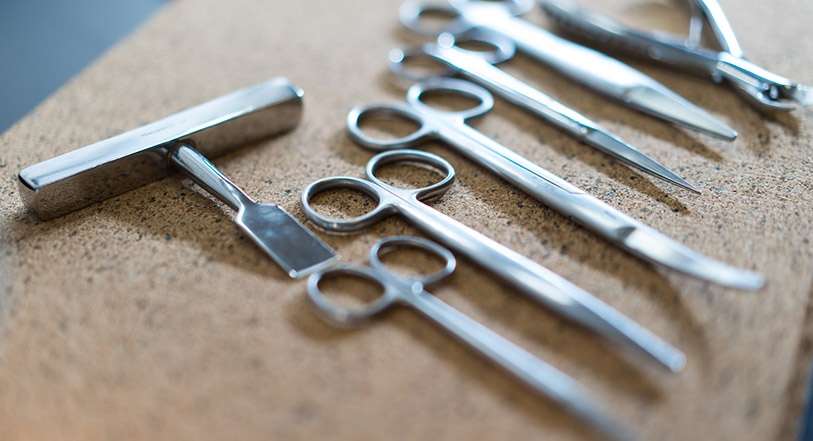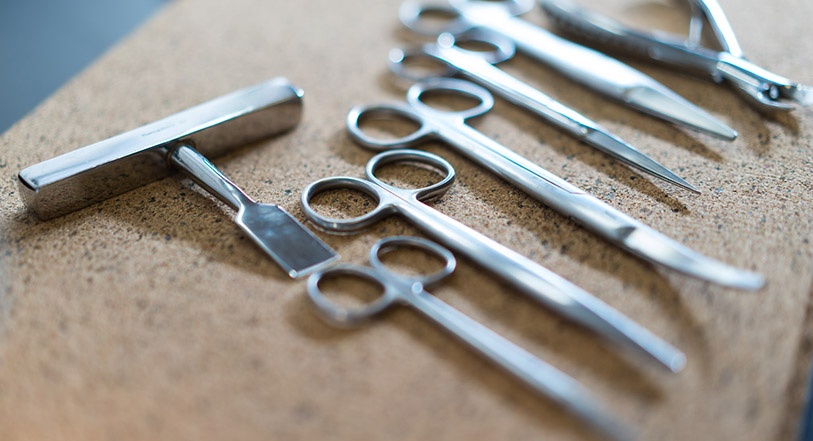
Standardization of necropsy techniques is important for consistency and comparability between animals and dose groups. It also aids in minimizing the amount of autolysis that may occur during necropsy, which is particularly important in susceptible organs like the liver, pancreas, kidney and especially the gastrointestinal (GI) tract.
An abundance of resident bacteria along the tract leave organs vulnerable to tissue destruction caused by advanced autolysis. Although there will be some low-level, inevitable autolysis that occurs immediately post-mortem, an experienced veterinary pathologist will recognize these intrinsic, enzyme-induced changes and will be able to evaluate the tissues as planned. However, more pronounced artifacts that occur with subsequent, bacterial-derived autolysis could make assessment of pathological tissue changes next to impossible. Precautions should be employed to avoid this detrimental, secondary autolysis during the necropsy; the most effective of which is to shorten the interval between time of death and tissue fixation.
All too often we receive poorly fixed sections of small and large intestines in our lab, which makes everyone’s job more difficult and wastes time. The trimming technician has a difficult time sampling the proper segment because he or she can not always properly identify each segment. Once slides have been prepared, it is the job of the quality control technician to view each section microscopically before it goes to the pathologist. The QC technician often has a difficult time identifying the different intestine section correctly because their shape, landmarks, cellular detail and epithelium is difficult to identify due to the necrosis. Most importantly, when sections of small and large intestines are received autolyzed due to poor necropsy techniques, the pathologist cannot properly evaluate the sections, thus leading to an incomplete evaluation.
The following is a list of standardized (and simple) necropsy techniques specifically for the gut. Follow these basic instructions for the most consistent necropsy results.
- Open the abdomen, xiphoid to pubis.
- Infuse the GI tract with 10% neutral buffered formalin to fix and preserve the contents and mucosa in situ. Inject fixative into various places along the intestinal loops. If the animal has a gallbladder, inject it with a small amount of formalin also.
- Gently lift out all abdominal contents together. If necessary, remove adrenal glands, ovaries, kidneys and liver to facilitate removal of the gut. Examine organs, weigh them, record any abnormalities.
- Extend the GI tract gently from stomach to rectum. The intestinal mucosa is very sensitive, and gentle handling must be employed at all times. Dissect off the mesentery, lymph nodes, and pancreas.
- Submerge all tissues in fixative (at least 10x their volume).
NOTE: see subsection (A) and (B) for special instructions related to intestines
- For small animals, the segments of intestines as well as the colon and rectum should be flushed with saline followed by a flush with fixative and placed immediately into a container of fixative. It is preferred NOT to open the cecum, but leave it intact, inflate with fixative, and save in the container of fixative.
- For large animals, the segments of intestines to be submitted in fixative should be opened, gently rinsed with saline and then stapled to a piece of rigid plastic. The mucosal surface should face out when stapled. During all handling, it is crucial that attention be paid in order to avoid manipulating, damaging, or otherwise mishandling the mucosa.
- After allowing a few minutes of fixation, take the unopened stomach and open it along the greater curvature. Lay it flat on a piece of cardboard to allow flat glandular/non-glandular sectioning of the stomach.
Optimal fixation of all tissues is crucial for accurate processing and microscopic evaluation in the veterinary pathology laboratory. Fixation of the GI tract must occur as early as possible in the necropsy due to the high risk of autolysis and sensitivity to other known/potential toxicants. It is also imperative that the fixation is complete, penetrating the internal mucosa as well as the outside of the organs. Follow these standardized steps to ensure the best possible pathology evaluation.

